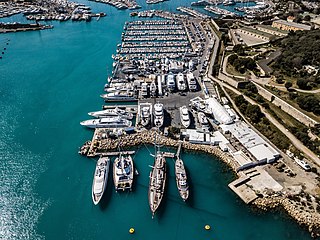
A shipyard, also called a dockyard or boatyard, is a place where ships are built and repaired. These can be yachts, military vessels, cruise liners or other cargo or passenger ships. Compared to shipyards, which are sometimes more involved with original construction, dockyards are sometimes more linked with maintenance and basing activities. The terms are routinely used interchangeably, in part because the evolution of dockyards and shipyards has often caused them to change or merge roles.

Cam Ranh Bay is a deep-water bay in Vietnam in Khánh Hòa Province. It is located at an inlet of the South China Sea situated on the southeastern coast of Vietnam, between Phan Rang and Nha Trang, approximately 290 kilometers northeast of Ho Chi Minh City.

Operation Sealords was a military operation that took place during the Vietnam War.
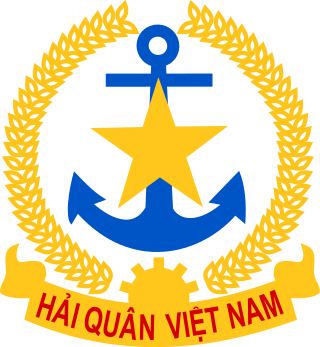
The Vietnam People's Navy, internally the Naval Service, also known as the Vietnamese People's Navy or simply Vietnam/Vietnamese Navy, is the naval branch of the Vietnam People's Army and is responsible for the protection of the country's national waters, islands, and interests of the maritime economy, as well as for the co-ordination of maritime police, customs service and the border defence force.
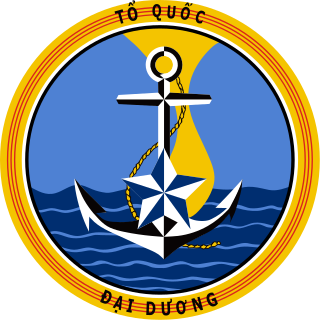
The Republic of Vietnam Navy was the naval branch of the South Vietnamese military, the official armed forces of the former Republic of Vietnam from 1955 to 1975. The early fleet consisted of boats from France; after 1955, and the transfer of the armed forces to Vietnamese control, the fleet was supplied from the United States. With American assistance, in 1972 the VNN became the largest Southeast Asian navy and, by some estimates, the fourth largest navy in the world, just behind the Soviet Union, the United States and the People's Republic of China, with 42,000 personnel, 672 amphibious ships and craft, 20 mine warfare vessels, 450 patrol craft, 56 service craft, and 242 junks. Other sources state that VNN was the ninth largest navy in the world. The Republic of Vietnam Navy was responsible for the protection of the country's national waters, islands, and interests of its maritime economy, as well as for the co-ordination of maritime police, customs service and the maritime border defence force.

The JSC Admiralty Shipyards is one of the oldest and largest shipyards in Russia, located in Saint Petersburg. The shipyard's building ways can accommodate ships of up to 70,000 tonnes deadweight (DWT), 250 metres (820 ft) in length and 35 metres (115 ft) in width. Military products include naval warships such as nuclear and diesel-powered submarines and large auxiliaries.

Garden Reach Shipbuilders & Engineers Ltd, abbreviated as GRSE, is one of India's leading shipyards, located in Kolkata. It builds and repairs commercial and naval vessels. GRSE also builds export ships.

The Black Sea Shipyard is a shipbuilding facility in Mykolaiv, Ukraine, on the southern tip of the Mykolaiv peninsula. It was founded in 1895 by Belgian interests and began building warships in 1901. At the beginning of World War I in 1914, it was one of the largest industrial facilities in the Russian Empire. The shipyard was moribund in the first decades of the Soviet Union until the Soviets began building up their fleet in the 1930s and it began building surface warships as well as submarines. The yard was badly damaged during World War II and took several years to be rebuilt. Surface warship construction temporarily ended in the mid-1950s before being revived in the mid-1960s and submarines were last built in the yard in late 1950s. The Black Sea Shipyard built all of the aircraft carrying ships of the USSR and Russia and continued before it was liquidated by the economic court of Mykolaiv Oblast on June 25, 2021.

USCGC Point Marone (WPB-82331) was an 82-foot (25 m) Point class cutter constructed at the Coast Guard Yard at Curtis Bay, Maryland in 1962 for use as a law enforcement and search and rescue patrol boat. Since the Coast Guard policy in 1962 was not to name cutters under 100 feet (30 m) in length, it was designated as WPB-82331 when commissioned and acquired the name Point Marone in January 1964 when the Coast Guard started naming all cutters longer than 65 feet (20 m).

USCGC Point Hudson (WPB-82322) was an 82-foot (25 m) Point class cutter constructed at the Coast Guard Yard at Curtis Bay, Maryland in 1961 for use as a law enforcement and search and rescue patrol boat. Since the Coast Guard policy in 1961 was not to name cutters under 100-foot (30 m) in length, it was designated as WPB-82322 when commissioned and acquired the name Point Hudson in January 1964 when the Coast Guard started naming all cutters longer than 65-foot (20 m).

USCGC Point League (WPB-82304) was an 82-foot (25 m) Point-class cutter constructed at the Coast Guard Yard at Curtis Bay, Maryland in 1960 for use as a law enforcement and search and rescue patrol boat. Since the Coast Guard policy in 1960 was not to name cutters under 100-foot (30 m) in length, it was designated as WPB-82304 when commissioned and acquired the name Point League in January 1964 when the Coast Guard started naming all cutters longer than 65-foot (20 m).
USCGC Point Slocum (WPB-82313) was an 82-foot (25 m) Point class cutter constructed at the Coast Guard Yard at Curtis Bay, Maryland in 1961 for use as a law enforcement and search and rescue patrol boat. Since the Coast Guard policy in 1960 was not to name cutters under 100-foot (30 m) in length, it was designated as WPB-82313 when commissioned and acquired the name Point Slocum in January 1964 when the Coast Guard started naming all cutters longer than 65-foot (20 m).

USCGC Point White (WPB-82308) was an 82-foot (25 m) Point class cutter constructed at the Coast Guard Yard at Curtis Bay, Maryland in 1961 for use as a law enforcement and search and rescue patrol boat. Since the Coast Guard policy in 1961 was not to name cutters under 100 feet (30 m) in length, it was designated as WPB-82308 when commissioned and acquired the name Point White in January 1964 when the Coast Guard started naming all cutters longer than 65 feet (20 m).

The U.S. Naval Forces, Vietnam was a command of the United States Navy, active during the Vietnam War, from 1 April 1966 to 29 March 1973.

The Junk Force officially the Coastal Force was a naval security unit of the Republic of Vietnam, composed of civilians trained by the Navy and working in conjunction with the Republic of Vietnam National Police. The Force was formed in 1960, and integrated into the Republic of Vietnam Navy (RVNN) in 1965.
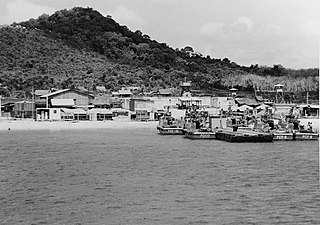
An Thoi Naval Base is a former Republic of Vietnam Navy (RVNN), United States Navy, and U.S. Coast Guard base in the town of An Thới, Phú Quốc island in southwest Vietnam.

Nhà Bè Base is a former U.S. Navy and Republic of Vietnam Navy (RVNN) base in Nhà Bè District in Saigon of Vietnam now used as a base by the Vietnam Coast Guard.
Nam Can Naval Base is a former Republic of Vietnam Navy (RVNN) and United States Navy in the town of Năm Căn, Cà Mau Province in the extreme south of Vietnam.
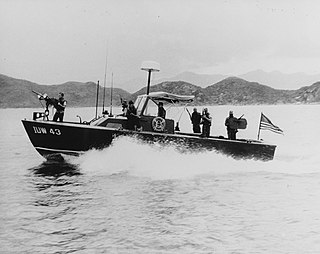
Operation Stable Door was the United States Navy and Royal Australian Navy's harbor defense operation during the Vietnam War. This operation complemented Operation Market Time designed to prevent infiltration along the South Vietnamese coast.

Trần Văn Chơn was a Vice Admiral of the Republic of Vietnam Navy (RVNN) and commander of the RVNN from 1966 to 1974.



















